As I reported on Tuesday, a major organizational shift is taking shape at the Oregon Department of Transportation (ODOT). For the first time ever, ODOT will have an official Active Transportation “section” within the agency.
ODOT Director Matt Garrett made the announcement yesterday via an internal email, saying it was one of the agency’s “first steps to pursue a more multimodal vision.”
Not unexpectedly, reactions to the news were mixed. Those close to ODOT (staff, advisory committee members, and so on) are excited about the announcement, while those on the outside looking in (advocates, citizen activists, city staff), are skeptical.
“The citizens of Oregon have been asking for a more diverse portfolio of ways to get around the state as fuel prices rise and as people don’t have the money in their household to have one car per person.”
— Lynn Peterson, transportation policy adviser to Governor Kitzhaber
In a nutshell, ODOT says the move is intended to make it easier for communities to implement bicycling and walking projects. They plan to bring together non-highway staff and programs (like Safe Routes to Schools, the 1% set-aside from the Bicycle Bill, state bike/ped grants, Transportation Enhancements, and so on) under one roof in hopes of a more collaborative, strategic and holistic approach to project planning and implementation.
The problem currently is that each one of those programs are scattered throughout ODOT, tied to different funding sources (some state, some federal) and cycles, and overseen by a dizzying array of divisions and managers. The result is confusion, wasted time (wading through the bureaucracy), and projects (if they get done at all) that serve the process instead of the desired outcome.
ODOT hopes the changes will solve those problems.
In addition to a physical change of location, the org chart shuffling puts the Active Transportation Section in position to someday become a full-fledged “Division” within ODOT — carrying the same internal weight as the vaunted Highway Division.
A.J. Zelada, the Chair of the Oregon Bicycle and Pedestrian Advisory Committee (OBPAC) calls the move a “breath of fresh air” and a “terrific celebration of the 40th anniversary of the Oregon Bike BIll.” Zelada, (speaking for himself, not the OBPAC) says having a single section for all active transportation programs within ODOT is like “breaking a glass ceiling.”
According to ODOT, the move is a natural evolution, spurred by years of grumbling by ODOT staff, stakeholders, and even by Gail Achterman — Chair of the Oregon Transportation Commission (OTC), the governor-appointed advisory committee that sets policy for ODOT.
You’ll recall that Achterman hinted at her frustrations at the 2010 Oregon Bike Summit. During a keynote speech at that event, Achterman said an analysis of the Byzantine nature of biking and walking funding and programs was “thought-provoking.” “It shows we’ve got dribs and drabs of money across a whole bunch of program areas,” she said.
In an interview yesterday, Achterman said she’s “very excited” about the changes being made.
“It brings all the people working in all these different programs together as one team, all reporting to the same person so that we can have them all applying their expertise to the community problems all at the same time. That kind of team development never happened because it’s hard when you’re in different buildings with different people to report to.”
Asked for an example of how the new section might impact bicycle project implementation, Achterman brought up the Oregon Bicycle Bill (a minimum 1% of highway project money must be spent on bicycling and walking improvements) and the bike lanes on Highway 97 in Bend.
“Does it really make the most sense to spend it on the highway project [which is the common practice at ODOT currently], or to spend it on some other bike project that the community has already prioritized?”
Think of the new Active Transportation Section like a clearinghouse within ODOT, where a team of experts work in collaboration to make sure every non-highway dollar spent in Oregon gets maximum bang for the buck. On that team will be people like Sheila Lyons, who has toiled valiantly as the manager of ODOT’s Bicycle and Pedestrian Program.
For years, Lyons has been buried way down the org chart, making it hard for her to muster the staff resources or internal respect given to her highway counterparts. With the re-structuring, Lyons will go from 7-8 people down the org chart (see below), to only having to report to one manager before getting to Director Matt Garrett. “It’s a move up, it’s better recognition,” an ODOT staffer told me.
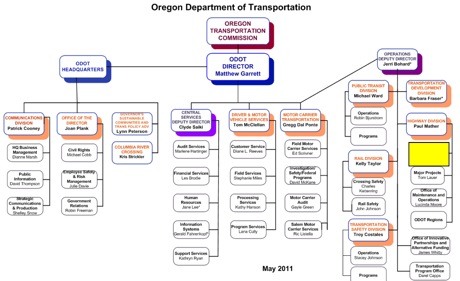
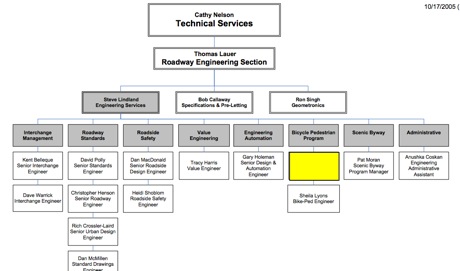
Beyond just internal pressure to change the way active transportation business is done in our state, Lynn Peterson thinks some credit for this structural shift at ODOT belongs to Oregonians. Peterson, the former Chair of Clackamas County who recently took the position of transportation policy adviser to Governor Kitzhaber, said during an interview yesterday that, “The citizens of Oregon have been asking for a more diverse portfolio of ways to get around the state as fuel prices rise and as people don’t have the money in their household to have one car per person.”
Peterson, who is very well-respected among Portland biking and walking advocates, says ODOT’s move is a “good first step toward a 21st Century transportation system.”
“What he [Matt Garrett] has done, is acknowledge that we really are looking at the health of communities over the long run,” added Peterson, “It doesn’t mean you won’t own a car, it means you’ll have the choice to walk or bike.”
From ODOT’s perspective, the move is a way to squeeze as much impact as possible from limited funds. ODOT spokesman Patrick Cooney says the biggest barrier to building non-highway projects is that, “Most of the funding we get is dedicated to highways and we have no choice in the matter.” So, when money is available for biking and walking, Cooney says the new organizational structure will allow better decisions to be made on how to spend it.
“Too many of these non-highway programs are worked on in a vacuum, not in terms of the context of what’s going on… This is the Director’s effort to look at these different programs as parts of a whole rather than individual, specific programs.”
While Director Garrett’s memo about the move scared some people with mentions of “right-sizing” the agency and becoming more “cost-effective,” (terms that are often code words for slashing programs) OTC Chair Actherman says those reactions are “reading the worst into it.”
“What we’re trying to do,” she says, “is make sure we maximize the effectiveness by not siloing things.”
An added benefit, Achterman notes, is that by bundling all the non-motorized programs under one section, it will make a stronger case for more funding. Achterman says she and Garrett are actively looking for a new dedicated funding source for projects outside of highway right-of-way.
“As a (OTC) commissioner, from a budget perspective, right now we see all these little snippets, they’re all like little tiny things; whereas, when we look at the maintenance or bridge budget, we’re looking at a real rigorous system for evaluating needs.”
The new Active Transportation Section, Achterman feels, will give the OTC a clearer picture of non-highway funding needs, which will lead to better outcomes for them in the state budget process.
Another key player who is optimistic about the changes is director of Cycle Oregon and organizer of the Oregon Active Transportation Summit, Jerry Norquist. Norquist is a tireless advocate for bicycling at the state level.
“I’m excited, it’s been a long time coming,” he told me yesterday.
Norquist says official recognition of active transportation from ODOT is a big deal. “It elevates the whole program,” he said, “Sheila [Lyons] has been doing good work, but it’s been on the backburner, this puts it toward the front, as it should be.”
While ODOT’s move is being given high praise, many are taking a wait-and-see approach.
You can’t blame some for being skeptical of ODOT’s motives. The agency manages state highways that claim the majority of traffic crash victims, they’re seen by many as being highway-centric and they (with Garrett at the helm) are pushing hard for the controversial Columbia River Crossing (CRC) project.
Economist and outspoken ODOT critic Joe Cortright says, given their “relentless” support of the CRC, he doesn’t trust what ODOT says. “Let’s watch what they do, especially how they allocate resources.”
Given ODOT’s mixed track record, many advocates and insiders around the state will be watching very closely to see how this evolves. “Time will tell” was a common refrain among many people I spoke with for this story.
For Zelada, the citizen activist and Chair of the OBPAC, it’s a time to celebrate a momentous step forward:
“The fact that we have crested a hill and we are listened to is just simply excellent, monumental, a tipping point, and a time for not only simple joy but a time to put our minds and hearts to work even more earnestly. There is much to do. Do not rest. Mountains are ahead.”
ODOT Director Matt Garrett plans to formally present the changes to the OBPAC at their meeting in Salem on July 22nd.


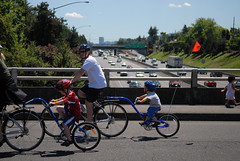
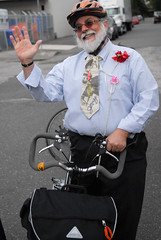
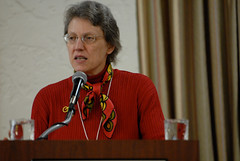
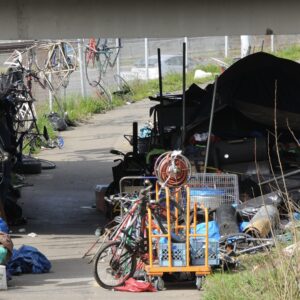

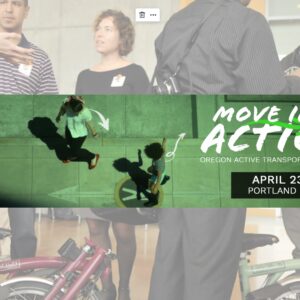
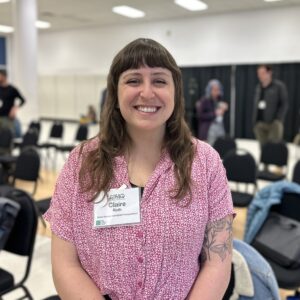
Thanks for reading.
BikePortland has served this community with independent community journalism since 2005. We rely on subscriptions from readers like you to survive. Your financial support is vital in keeping this valuable resource alive and well.
Please subscribe today to strengthen and expand our work.
I think this is step 2 of a 3 step process.
Step 1- be auto-dominated
Step 2- create a ‘active transpo division’
Step 3- scatter those folks throughout the department and make all projects multimodal
Matt Garrett is still pushing for the $10 Billion CRC, which will set our region’s transportation planning back 50 years, regardless of how he shuffles the org charts.
expecting large paradigm shifts from government agencies is a waste of time in general. I don’t expect the “new era” to arrive anytime soon.
Especially at a time when federal funding sources are being eviscerated, it’s encouraging to hear an intent to secure and streamline funding for active trans projects at the state level. I’m willing to give ODOT a chance to impress me with their avowed re-focusing of priorities. My optimistic side says that this sounds like a major re-structuring and a total pain in the ass for the Department that wouldn’t have been announced unless there was considerable muscle and political will dedicated to making it happen… in a culture that is still predominantly auto-oriented, it doesn’t seem like something ODOT could do to win friends in business or government. I want so badly for this to be a move of actual leadership.
Well, if they’re looking for opportunities to put their money where their mouth is, there’s a sizeable list of projects they could start with. Like this CRC thing, for example.
Regarding the Oregon Bicycle Bill and the CRC, would I be correct in believing that a $4 billion price tag means that $40 million must be spent on cyclist and/or pedestrian improvements?
absolutely.
Greenwash.
As an unusually suspicious, pessimistic, paranoid and cynical person I too fear that this consolidation of fiscal power over active transport projects could be bad.
This is balanced by a bit of experience and logical deduction. From my time with a security clearance I learned something about “Area 51” type conspiracies: people are people no matter what they do. 3 people cannot keep a secret if 2 of them are dead; the last guy will try to use that secret to talk his way in to the pants of some girl at a bar.
On the ODOT topic: power brokers with ill intent exist now and they will exist if this structural changes occurs or not. These “forces of corruption” don’t like change any more than anyone else as it
makes them vulnerable to attack during transition.
Once the new system settles down more corruption will emerge; this is a simple fact of government that the US founding fathers understood. Design government’s laws to protect the people from the government and the government from itself.
This is an evolutionary process: this consolidation of power will be followed by a decentralization process some years down the road. But in the mean time we will have learned new ways to game the system; perhaps we will become a force of corruption.
As a local gov’t employee who deals with conflicting programs, priorities and funding from ODOT, I hope this effort will reduce (but likely not eliminate) problem areas that exist today. It could be a step in the right direction, and lead to a more balanced department and funding system than we have today.
Thank you for the update, Jonathan. I really want to believe that this will be a good thing, I really do. ODOT has one chance to prove it to me.
The reality is that the ODOT is the only ODOT we have.
This sounds quite good. General idea seems to be that it would allow all the little bits of active transportation monies derived from road transportation projects and other sources, to be refocused where needed, on key active transportation improvement projects.
The new ‘section’ would be able to do this rather than be obliged to stand by and watch that money get spent on less urgently needed improvements.
A.J. Zelada…hmmm. Kind of an unusual name. That guy has an extraordinary resemblance to a former Portland mayor…what was his name? Oh…right…Bud Clark. Glad to see Clark has inspired others to take up his flamboyant personal style and dedication to civic involvement.
There is a lot of potential upside to this development. The active transportation planners here are so good at what they do, I think moving them up in the organization can only help. The second fail-safe is the people reading this blog. I would expect a higher level of accountability given the fact that so many people here care about active transportation. The activists, like the planners, understand that funds are always at a premium and I think will be likely to agree on how to move forward on specific funding tracks and projects.
Next stop: raise the bike bill from one to two percent!
Pneumatic tubes for trash Disney style.
Higher initial outlay, no vehicle costs, no fuel costs, no labor costs, much lower maintenance cost.
heres a test for this new ODOT: that crazy I-5 NE Broadway/Weidler interchange project they proposed by the rose quarter.
Which one are you talking about? I kinda like the ridiculous huge roundabout idea.